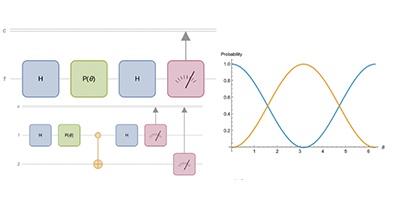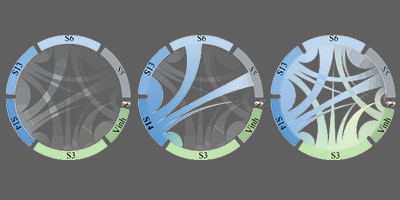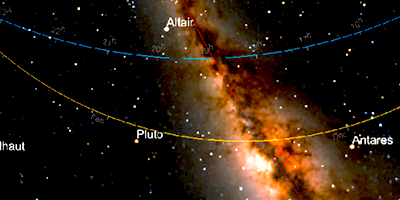Liberal Arts, Meet Computation A Wolfram Community Introduction

We can guess if you’re reading the Wolfram Blog that you’re probably a Wolfram Language user, whether as a recreational programmer, a physics professor or a high-powered data scientist. And let’s be honest about another thing: if you’re using it to solve algebraic integrals or analyze SARS-CoV-2 genetic sequences or some other complex subject, you’re likely a big-brained person. I mean, you’re investigating the very nature of the universe in all its facets, right?
So what’s the problem? Well, there isn’t one—except maybe all those people (well-meaning friends, family members or even colleagues)—who have no understanding of what you do. In their minds, it’s all just a big combination of ones and zeros with no place for the good, the true or the beautiful.
“Where’s the art?” they say. “Where’s the music? The poetry? How come your fancy-pants computational language can’t do anything with that?”
And they could very well be right… except for one critical factor: they’re not. If you’re talking with a liberal arts major—or worse, an angry mob of them, with metaphorical torches and pitchforks—you can find common ground: by using the very foundations of classical learning contained in the trivium and the quadrivium.
You might think I’m wrong… but I’m not. The proof is in the evidence, so let’s take a close look at some Wolfram Community posts that exemplify classical liberal arts subjects.
The Trivium
The idea of the trivium—grammar, logic and rhetoric—dates back to Plato’s dialogues, but the term itself was not used until the eighth-century Carolingian Renaissance. (And for someone like my dad, who wrote his dissertation about a seventeenth-century Andrew Marvell poem, it’s pretty much the be-all and end-all of higher education.) Wolfram Community has posts, however, that directly relate to all three subject areas.
Grammar: A Wolfram Language Facsimile of Wordle »
David Reiss

Wordle took the world by storm at the end of 2021 and remains popular, even after losing some of its luster when it was sold to the New York Times earlier this year. The premise is simple enough: you have six guesses to figure out the word of the day. A yellow letter means you guessed the right letter, but it’s in the wrong position. A green result means both the right letter and the right spot.
The result is a game that forces you to think about how words are constructed. For example, what’s the best word to use for your first guess? And things get tougher as you eliminate more letters with each guess. How many consonant pairs remain? How many vowels? How can you best utilize your remaining guesses?
Unfortunately, you can only play the official Wordle game once a day. Many people want to play more often than that, including David Reiss, so one slow Sunday evening he decided to create his own facsimile version: MWordle. Using only a couple hundred lines of code, Reiss demonstrated the power of the Wolfram Language as well as its flexibility for recreational computing.
Logic: Using Kleene and Priest Logic Rules to Create Ternary
Logic Tables »
Taha Shaikh

I’d always thought of computer logic and rhetorical logic as two completely separate things. After all, computers ultimately use zeros and ones, while building a logically sound argument depends on kairos—appropriateness to audience—and based on that, deciding whether to use ethos, pathos or logos for your appeal. That is to say, rhetorical arguments seemed to be much gooier than computer logic.
Then I came across this Wolfram Community post about ternary logic tables. Instead of just true or false, there is a third logical condition, which can be described as a “strong logic of indeterminacy” (Kleene) or a “logic of paradox” (Priest). The only consideration I’d had about a condition other than true or false was in an episode of Futurama, when the robot Bender wakes up from a nightmare and moans, “Ones and zeros everywhere… and then I thought I saw a two.” Who’d a thunk, right?
Another interesting thing about this post is it was written when Taha Shaikh was a student at the 2017 Wolfram High School Summer Camp. That was another thing that I didn’t know about Wolfram when I started working here: our significant allocation of resources devoted to training the next generation of scientists. From Wolfram U open online courses to Daily Study Groups to summer camps, Wolfram is always working to help grow the number of people able to perform computational analysis.
Rhetoric: Commercial Text-Image Sentiment Analysis Timeline »
Aryan Dawer

As useful as it is to know how to construct a sound argument, it’s as or more important to know how to critically analyze other rhetorical objects: a journal article, a news story, an advertisement. The lack of sound critical thinking is one of the greatest weaknesses in modern American discourse because people are more concerned with how “things” make them feel—and most often in lieu of hard evidence as to why that’s the case—as opposed to understanding how those rhetorical objects are constructed.
One of the great strengths of computational analysis is the ability to identify and filter various types of information. Sure, an investigation may have to do with algebraic integrals, but as Aryan Dawer’s post shows, it also includes analysis of rhetorical and visual strategies in television advertisements. By combining dialogue and image data as it appears in the ad’s timeline, the resulting analysis reached interesting, empirical conclusions about how fear and happiness are used at different points to promote the purchase of products.
The comments at the bottom of his post also illustrate another strength of Wolfram Community: that these computational explorations are starting points for wide discussions. One commenter pointed out that adding some statistical analysis could result in a journal-worthy article. Even better, he points to a similar example using computational analysis to examine gender bias in movies.
The Quadrivium
Another paradox with someone getting on their high horse about the trivium—à la “Who needs math when you know what rhetoric is and how it works?”—is that the quadrivium, the upper division of liberal arts, is all about numbers: arithmetic, geometry, music and astronomy.
Arithmetic: No Way to Express These Real Numbers with Real Radicals! »
Bill Gosper
Gosper, a longtime Wolfram Community member and contributor, first tells the readers of this post to watch the following Derek Muller video “How Imaginary Numbers Were Invented”:
To be honest, Gosper and Muller pretty much lost me after “Mathematics began as a way to quantify our world…”. But that’s likely because in the quadrivium, arithmetic is the study of numbers in the abstract, so I don’t have much to hold onto with the discussion of imaginary and real numbers.
Again, however, I think what’s key here is the way Wolfram Community isn’t an insular, circumscribed world cut off from outside discourse and discussion. Instead, Gosper uses his post to respond to Muller’s video and notes that “Derek wisely avoided the following wrinkle: [a] cubic can have all three roots real, yet inexpressible with real radicals!” Gosper then goes on to explore the issue laid out in his title: no way to express these real numbers with real radicals.
As a teacher, I always encouraged my students to frame their points/ideas within the larger overall discussions relating to their subjects. Otherwise, they risked reinventing the wheel or taking a position already easily proven (or disproven). The production of new knowledge is often a collaborative process, which Gosper shows twice: first by responding to Muller’s video and by doing so on Wolfram Community.
Geometry: The Memory of Persistence: a Humble Tribute to
Salvador Dalí »
Daniel Sander Hoffmann

Geometry is the the study of numbers in space, which first leads me to think of using rulers and compasses to draw endless triangles, quadrilaterals and circles. Instead, what Hoffman does in his Wolfram Community post is first use the Wolfram Language to generate a variety of custom clock faces. Then, he combines and “melts” them to create his final image: an homage to Surrealist artist Salvador Dalí.
Behind Hoffman’s image itself, however, is the reason he made it: to enter into Wolfram’s 2022 Computational Art Contest. Much as poetry slams—competitive poetry contests than began in the 1980s—reinvigorated moribund poetry readings, computational art contests like this one allow for the creative—and competitive!—expression of math beyond numbers on a page.
Music: Play with Music Scales Samples »
Claudio Chaib

Music has the power to provoke strong emotional responses in listeners, but at its heart, it’s the study of numbers in time. That means the Wolfram Language has the power to create musical audio output such as Chaib’s post that includes 30 different musical scales.
Beyond scales alone, however, there are multiple examples at Wolfram Community where people have used the Wolfram Language to create their own musical compositions. One example is “Generating Music with Expressive Timing and Dynamics,” which algorithmically generates original music using handcrafted rules and a custom neural network, and also includes dynamics in loudness and human-like timing mistakes.
Another thing to note is a comment at the bottom of Chaib’s Wolfram Community post from Daniel Lichtblau, who works in Wolfram’s Research and Development division. More than just offering praise for Chaib’s code, Lichtblau suggests he add some documentation and submit it to the Wolfram Function Repository. And in 2019, that’s what he did, so now anyone can use the MusicalScaleSample function.
Astronomy: Catch Comet C/2020 F3 (NEOWISE) Which Is Putting on Quite a Show »
Jeff Bryant

Astronomy incorporates the first three elements in the quadrivium by studying numbers in both time and space. And Jeff Bryant’s post about the appearance of Comet C/2020 F3 (NEOWISE) showcases what the Wolfram Language can do in multiple ways.
First, he used the Wolfram Language to import a picture of the comet he took at the Champaign-Urbana Astronomical Society’s Prairie Winds Observatory at the beginning of his Wolfram Community post. Then, he used multiple resource functions to visualize the comet’s orbit when it was closest to Earth. Finally, he called Wolfram|Alpha for a “more earthly view” of the comet’s path using a star chart. Numbers in space and time, indeed!
But this capability is not limited to comets. As an example of how Wolfram Community members build on each other’s work, this post modifies Bryant’s code to produce a six-month star chart for the UK. And it’s not limited to the Earth, either. In another post, Bryant plots a close encounter between a comet and Mars.
Keep Exploring!
For the sake of full disclosure, I’ll be the first to admit that I’m an anomaly compared to most of my Wolfram colleagues. Instead of a science background, I have a couple of degrees in English… and the last math class I took was when I was a freshman in college. So I have a lot more in common with liberal arts majors than big-brain scientists.
That said—and while I first thought I would be a stranger in a strange land when I arrived at Wolfram—that’s not turned out to be the case. Instead, after I discovered the full range of classical liberal arts subjects on display at Wolfram Community, I saw the connections to the world I’ve lived in for most of my life.
So I’m living proof there’s hope for those people who don’t understand what you’re doing with the Wolfram Language… you just have to lead them down the garden path on their terms.
| This Wolfram U computational explorations course examines a range of disciplines not traditionally associated with coding. |



Comments